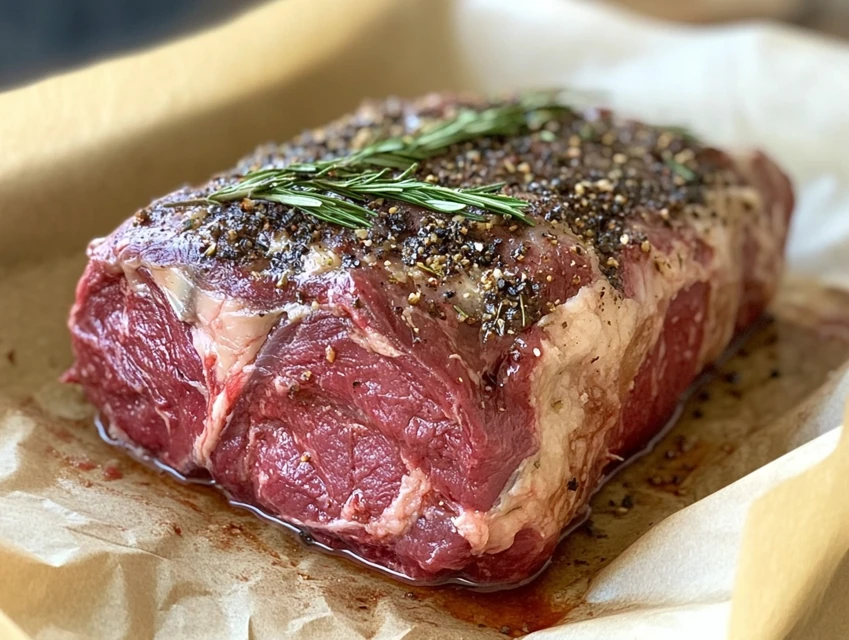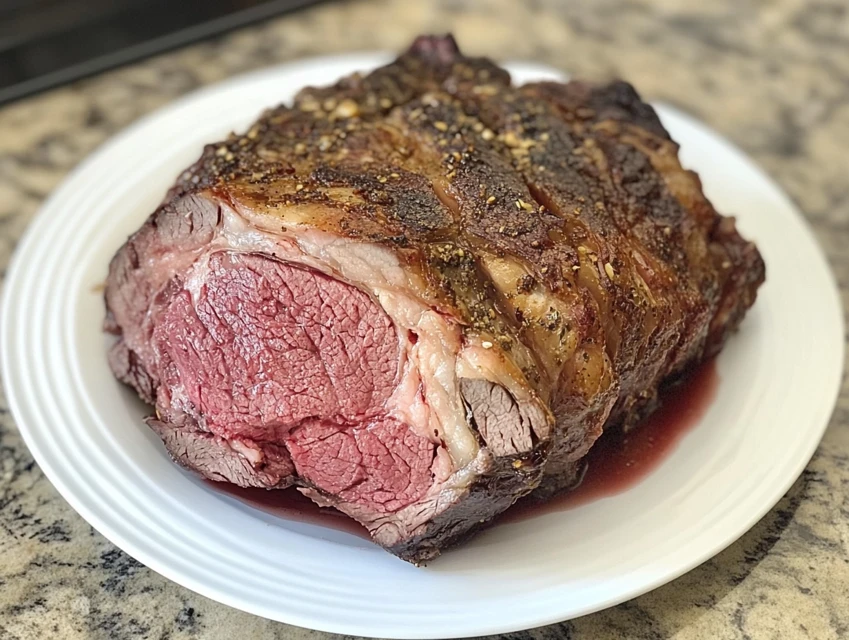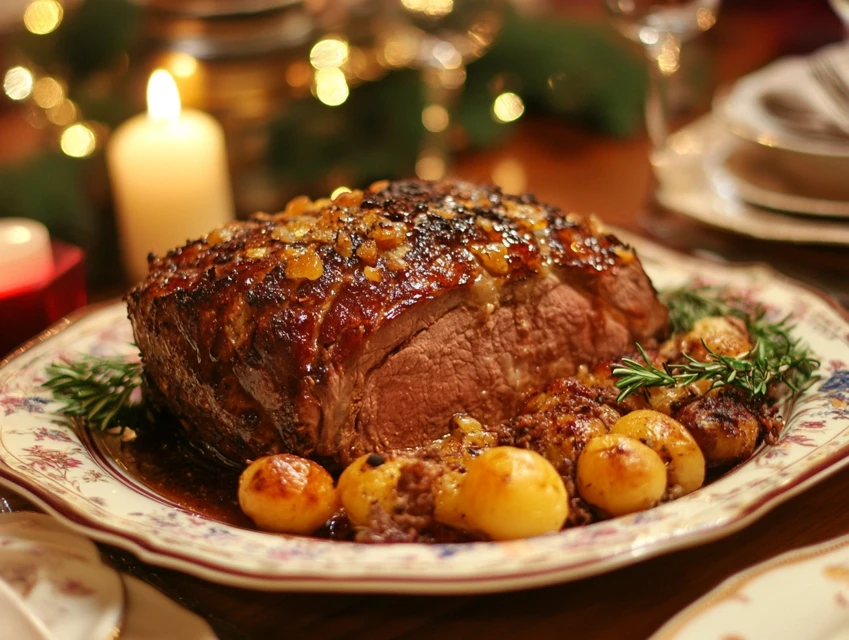A standing rib roast is the epitome of luxury at any special event. I’ve crafted a prime rib recipe that promises a tender, medium-rare delight. The key to success? A reliable meat thermometer. It ensures the prime rib reaches the perfect doneness.
Presenting a perfectly seasoned and cooked prime rib roast is a feast for the eyes and taste buds. It becomes the highlight of any meal.
Discovering the Elegance of a Perfect Prime Rib Roast
Key Takeaways
- Uncover the secrets to a perfect prime rib recipe, the jewel of special occasion meals.
- Learn about the essential role of a meat thermometer in achieving the perfect rib roast.
- Explore why the rib eye cut, when roasted whole, becomes an opulent centerpiece.
- Dive into the details of cook time, temperature, and preparation for a failproof standing rib roast recipe.
- Understand the importance of resting time to ensure a juicy and flavorful prime rib roast.
- Discover how to select the ideal rib roast for your gathering, accounting for size, grade, and cost.
- Gain tips on choosing the correct roasting temperature and serving sides that complement your prime rib.
Discovering the Elegance of a Perfect Prime Rib Roast

The elegance of prime rib is the star at any festive gathering. It’s a culinary delight that promises indulgence. As a seasoned home cook, I aim to master the perfect prime rib roast. This involves respecting the meat’s quality and appreciating the preparation process.
A perfect prime rib roast has a sumptuous, richly browned crust. Its sight alone can make guests exclaim with excitement. Achieving the tender, succulent interior is key to a memorable dish. Each slice offers a buttery texture and an aromatic presence that balances with its bold, beefy essence.
The journey to perfection starts long before the roast goes into the oven. Choosing a well-marbled cut and seasoning it with care are crucial steps. The cooking method, whether reverse searing or classic roasting, is also important.
Embracing the essence of a festive gathering means recognizing the joy a perfect prime rib roast brings. As the aroma fills the room, it shows my commitment to culinary excellence. It creates an atmosphere where stories are shared and the bounty is appreciated, making every dining experience unforgettable.
The elegance of prime rib is not just in its taste. It’s also in its ability to turn a meal into a celebratory feast. This act of love and culinary delight resonates with every guest long after the meal is over.
Choosing the Right Cut for Your Rib Roast Recipe
When I choose to make a standing rib roast, I pick the best cuts of beef carefully. The decision between a bone-in prime rib and other cuts greatly affects the dish. The USDA grades beef into Select, Choice, and Prime, but most stores sell Choice. I always choose Prime for a succulent roast and tender beef.
Selecting the Best Prime Rib
I look for certain features when picking prime rib. The meat should be a deep red or purple, showing it’s fresh. Each part of the bone-in prime rib serves about two people, so I plan my servings. It’s important to check the marbling, which should be evenly spread.
This marbling is key for a flavorful prime rib. It adds moisture and flavor as it melts during cooking. Even marbling ensures every bite is delicious and the cooking is even.
The Importance of Quality Marbling
Marbling is what makes prime rib so appealing. This fat in the meat adds moisture and flavor. A lot of marbling makes the prime rib juicy and flavorful.
I look for even marbling to make sure every bite is great. This also helps the cooking process.
Preparing and Seasoning the Prime Rib Roast
Seasoning the prime rib is key to its flavor. I start with salt and pepper, which add flavor and improve texture. I also add herbs like rosemary and thyme for extra taste.
Coating the rib with these herbs creates a flavorful crust. Letting the meat marinate in the fridge with these seasonings before cooking makes it even more flavorful and tender.
This careful selection and seasoning turn the standing rib roast into a special dish. Following these steps ensures my rib roast is always delicious and tender.
The Ultimate Guide to Cooking Prime Rib

As a passionate home chef, I love perfecting the art of the perfect rib roast. My kitchen has been my playground for learning the best oven roast instructions. I aim to make a prime rib that’s both succulent and flavorful, perfect for any special occasion. Here, I’ll share my insights and proven techniques for cooking the perfect prime rib.
Understanding the cut of prime rib is key. It comes from the rib section of the steer, known for its tenderness and flavor. A typical prime rib roast weighs between 20 and 30 pounds. For family gatherings, a 4-rib roast, serving about eight guests, is ideal for a standard oven.
Temperature control is crucial for cooking prime rib. To avoid overcooking, roast at around 200°F. This slow cooking tenderizes the meat without drying it out. For a crispy crust, briefly heat to 450°F to enhance the Maillard reaction.
Timing and seasoning are also vital. The right seasoning, including salt, herbs, and butter, boosts the meat’s flavor. I use specific seasoning ratios for different roast sizes, ensuring every bite is unforgettable.
Remembering the ideal internal temperatures is important. For a medium-rare prime rib, aim for an internal temperature of about 125°F. This ensures the meat is tender and juicy.
In conclusion, mastering the perfect rib roast combines science and art. It’s about understanding oven roast instructions, temperature control, and seasoning. Whether for a family meal or a grand dinner, the guide to prime rib I’ve shared will help you create a dish that’s celebrated.
Achieving the Perfect Doneness for Prime Rib

Perfect prime rib cookery is all about hitting the internal temperature for that medium rare doneness. It’s a journey that enhances flavors and textures, making prime rib a hit at any event.
The Art of Cooking to Your Preferred Temperature
My method for perfect prime rib starts with a high heat of 450°F. Then, it’s lowered to 325°F to cook it gently to 130-135°F. This careful process ensures every slice is just right.
Using a Meat Thermometer for Precise Cooking
A meat thermometer is essential for precise cooking. I insert the probe into the thickest part, avoiding bone and fat. This way, I know exactly when to pull it out at 135°F for that perfect medium-rare.
With these techniques, achieving perfect doneness in prime rib is not just a goal. It’s a reality that brings joy and satisfaction to every dish.
Mastering the Sear: Unlocking Flavor in Your Rib Roast
Mastering the sear is key to a perfect rib roast. It involves searing the meat at high temperatures. This step makes the meat look great and taste even better.
Choosing a USDA Prime cut from Costco’s meat department is a good start. Letting the prime rib sit at room temperature for 60-90 minutes helps it cook evenly.
Marinating the roast overnight adds to its flavor. Cooking it at 450°F for a few minutes sears the outside. Then, lowering the oven to 325°F cooks it gently. Letting it rest for 20-30 minutes after cooking makes each slice juicy and full of flavor.
The reverse sear method adds a burst of flavor at 500°F for the last 10 minutes. This method, along with careful timing and temperature, creates a perfect rib roast. It’s a hit at any gathering.
Cooking a perfect rib roast is more than just a meal. It’s a special ritual that makes every bite satisfying. Whether it’s for a big event or a family dinner, the right techniques make the meat taste amazing.
Timing Is Everything: Prime Rib Roast Cook Time and Rest Time
Knowing the cook time per pound and rest time is key for a perfect prime rib roast. A good timing plan helps your roast turn out right, keeping it moist and flavorful.
Calculating Cook Time Per Pound
For a prime rib roast, use cooking charts for the best results. The cooking time changes based on how rare you like it: about 35 minutes per pound at 225 degrees F for rare, and 40 minutes per pound for medium. Lowering the temperature after searing to 225°F keeps it tender and juicy.
The Importance of Letting Your Prime Rib Rest
After cooking, letting your prime rib rest is vital. A 30-minute rest lets juices spread evenly, making it juicy and flavorful. This rest is key for a great taste and presentation, with each slice perfectly cooked.
Bone-In or Boneless: Deciding on Your Prime Rib Roast Style
Choosing between bone-in vs boneless prime rib can change your meal’s taste and how you prepare it. Knowing the differences between rib roast choices is key for any chef or home cook. Let’s explore the details of each option to find the best for your event.
Bone-in prime rib is loved for its rich flavor. It cooks more evenly, making the meat juicy. The bones help distribute heat, making the meat next to them tender and flavorful.
A boneless prime rib roast is easier to carve and serve. It’s more uniform, which means it cooks evenly. This makes it a great choice for those who want a simple cooking and serving experience.
The choice between bone-in and boneless depends on what you value most. Both have their own benefits, whether it’s flavor and presentation or ease of cooking. Think about your effort level and the look you want to achieve. Choosing the right prime rib style will make your meal unforgettable.
Elegant Sides to Serve with Prime Rib Roast
Choosing the right complementary dishes is key when serving prime rib roast. My collection of 33 side dish recipes shows that perfect pairings often match the roast’s flavor. Potatoes, a favorite, appear in 6 recipes, proving their versatility and appeal.
For a bold taste, I suggest a hearty potato gratin or a flavorful rosemary roasted potato. These dishes complement the prime rib’s richness.
Adding greens brings color and balance to the meal. My 8 green-focused recipes, including Brussels sprouts, are a hit. Reviewers love my Brussels sprouts, praising their crispy texture and rich flavor, enhanced by bacon.
Bacon, found in about 24% of my dishes, adds a smoky touch that pairs well with earthy greens. This combo creates a memorable dish that complements the prime rib.
For creative elegant sides, about 21% of my recipes use cheese. This adds a creamy texture and a savory edge that contrasts with the prime rib. A standout is the cauliflower casserole with truffled Pecorino cheese, blending nuttiness with sweetness.
This dish, along with others using roasting and sautéing, makes the meal unforgettable. It’s not just about taste; it’s about creating a harmonious flavor symphony that enhances the prime rib.
Whether it’s the simple richness of roasted potatoes or the complex flavors of cheese casseroles, these sides make sure the prime rib roast shines. They are supported by a cast of equally impressive dishes.
Conclusion
Reflecting on my journey to prime rib mastery, I see the many details involved. Choosing the right cut and understanding the differences in beef quality are key. These steps lay the groundwork for a truly exceptional dish.
The cooking process is where the magic unfolds. Following the steps I’ve outlined, from seasoning to resting, is crucial. Using a digital thermometer ensures a perfectly cooked roast, no matter the desired doneness.
The final touches make a meal unforgettable. Sides like Au Jus Gravy and Sour Cream Horseradish Sauce add depth and flavor. Paying attention to ingredient ratios and measurements is essential for a balanced dish. By focusing on these details, you’ll create a memorable dining experience that showcases your skill in prime rib mastery.
FAQ
What makes a prime rib roast perfect for special occasions?
A prime rib roast is a stunning centerpiece for any special event. Its elegant look and delicious taste make it a standout. The browned crust and juicy inside are a true culinary delight.
How do you choose the best cut of beef for a rib roast recipe?
For the best rib roast, choose a well-marbled, bone-in prime rib. This cut offers the most flavor, tenderness, and juiciness. The bones help cook the meat evenly, and the fat makes it rich and succulent.
How should I prepare and season my prime rib roast?
To prepare your prime rib, keep it simple with kosher salt and pepper. Adding rosemary and thyme can boost its flavor. Salt the rib up to four days before to enhance the taste. This dry brining process makes the meat juicy and flavorful.
What is the ultimate guide to cooking prime rib to perfection?
The key to perfect prime rib is slow roasting at a low temperature. Then, blast it with high heat just before serving for a flavorful crust. Use a meat thermometer for precise temperature control.
How can I achieve perfect doneness for my prime rib?
To get perfect doneness, use a meat thermometer. Cook until it reaches 125 degrees Fahrenheit for medium-rare. Remember, the meat will continue to cook a bit after it’s taken out of the oven.
What is the secret to mastering the sear on a prime rib roast?
The secret to a great sear is a high-heat start. This creates a flavorful, browned crust. Then, slow roast it to your desired doneness. The initial sear locks in the flavors for a juicy result.
How do you calculate cook time per pound for prime rib?
To calculate cook time, start with a high temperature for a short time. Then, lower the oven temperature to finish cooking. Aim for about 15 minutes per pound for medium-rare, but always check with a thermometer.
Why is letting your prime rib rest important?
Letting the prime rib rest is key. It allows the juices to spread evenly, making the meat moist and flavorful. A 20-minute rest is recommended for the best results.
Should I choose bone-in or boneless prime rib roast, and why?
Choosing between bone-in or boneless prime rib depends on your preference. Bone-in roasts are often more flavorful and tender. Boneless roasts are easier to carve. Both options offer a delicious experience, but with slight differences in texture and flavor.
What sides should I serve with my prime rib roast?
Elegant sides for prime rib include potatoes, sautéed mushrooms, roasted Brussels sprouts, and creamy horseradish sauce. Choose sides that complement the prime rib’s rich flavor without overpowering it.


0 thoughts on “Perfect Prime Rib Roast Recipe for Special Occasions”